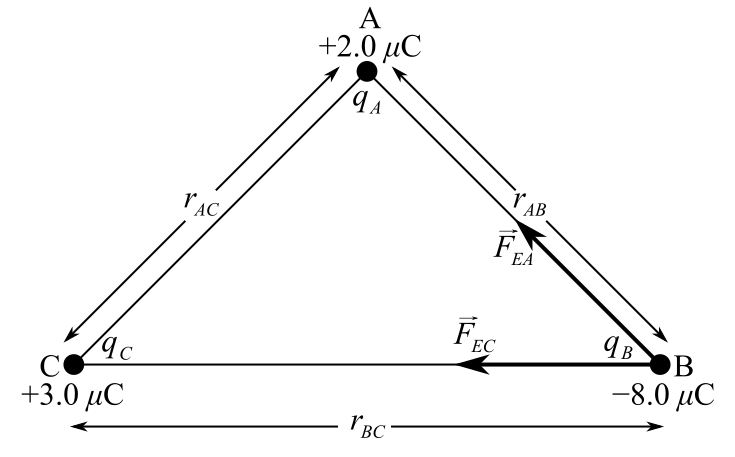
Concept explainers
Charges of +2.0, +3.0, and
The magnitude of force acting on the
Answer to Problem 32SP
Solution:
Explanation of Solution
Given Data:
The change on point A of the triangle is
The change on point B of the triangle is
The change on point C of the triangle is
The length of each side of the triangle is
Formula Used:
Write the expression for the electrostatic force:
Here,
The expression for resultant electrostatic force acting on one charge (test charge) due to presence of two other charges is given as
Here, Here,
Explanation:
Assume an equilateral triangle ABC having each side equal to
The electrostatic force exerted by charge placed at A on charged placed at C is

Here, first calculate the electrostatic force exerted by charge placed at A on charge placed at B. The expression for the electrostatic force is given as
Here,
Substitute
Now, calculate the electrostatic force exerted by charge placed at B on charge placed at C.
The expression for the electrostatic force is given as follows:
Here,
Substitute
Finally, we shall calculate the resultant force acting on charge placed at C due to the forces exerted by charges placed at A and C.
The expression for resultant electrostatic force acting on charge placed at C due to the forces exerted by charges placed at A and C is given as
Here, Here,
Substitute
Conclusion:
The magnitude of force acting on the
Want to see more full solutions like this?
Chapter 24 Solutions
Schaum's Outline of College Physics, Twelfth Edition (Schaum's Outlines)
- A point charge of 4.00 nC is located at (0, 1.00) m. What is the x component of the electric field due to the point charge at (4.00, 2.00) m? (a) 1.15 N/C (b) 0.864 N/C (c) 1.44 N/C (d) 1.15 N/C (e) 0.864 N/Carrow_forwardA very small ball has a mass of 5.00 103 kg and a charge of 4.00 C. What magnitude electric field directed upward will balance the weight of the ball so that the ball is suspended motionless above the ground? (a) 8.21 102 N/C (b) 1.22 104 N/C (c) 2.00 102 N/C (d) 5.11 106 N/C (e) 3.72 103 N/Carrow_forwardTwo particles with charges q1 and q2 are separated by a distance d, and each exerts an electric force on the other with magnitude FE. a. In terms of these quantities, what separation distance would cause the magnitude of the electric force to be halved? b. In terms of these quantities, what separation distance would cause the magnitude of the electric force to be doubled?arrow_forward
- Three charged particles are located at the corners of an equilateral triangle as shown in Figure P19.9. Calculate the total electric force on the 7.00-C charge.arrow_forwardA 1.75-nC charged particle located at the origin is separated by a distance of 0.0825 m from a 2.88-nC charged particle located farther along the positive x axis. If the 1.75-nC particle is kept fixed at the origin, where along the positive x axis should the 2.88-nC particle be located so that the magnitude of the electrostatic force it experiences is twice as great as it was in Problem 27?arrow_forwardA very small ball has a mass of 5.00 103 kg and a charge of 4.00 C. What magnitude electric field directed upward will balance the weight of the ball so that the ball is suspended motionless above the ground? (a) 8.21 102N/C (b) 1.22 104N/C (c) 2.00 102N/C (d) 5.11 106 N/C (e) 3.72 103 N/Carrow_forward
- A circular ring of charge of radius b has a total charge q uniformly distributed around it. Find the magnitude of the electric field in the center of the ring. (a) 0 (b) keq/b2 (c) keq2/b2 (d) keq2/b (e) None of these answers is correct.arrow_forwardIs it possible for a conducting sphere of radius 0.10 m to hold a charge of 4.0 C in air? The minimum field required to break down air and turn it into a conductor is 3.0 106 N/C.arrow_forwardPanicle A of charge 3.00 104 C is at the origin, particle B of charge 6.00 104 C is at (4.00 m, 0), and panicle C of charge 1.00 104 C is at (0, 3.00 m). (a) What is the x-component of the electric force exerted by A on C? (b) What is the y-component of the force exerted by A on C? (c) Find the magnitude of the force exerted by B on C. (d) Calculate the x-component of the force exerted by B on C. (e) Calculate the y-component of the force exerted by B on C. (f) Sum the two x-components to obtain the resultant x-component of the electric force acting on C. (g) Repeat part (f) for the y-component. (h) Find the magnitude and direction of the resultant electric force acting on C.arrow_forward
 Physics for Scientists and Engineers, Technology ...PhysicsISBN:9781305116399Author:Raymond A. Serway, John W. JewettPublisher:Cengage Learning
Physics for Scientists and Engineers, Technology ...PhysicsISBN:9781305116399Author:Raymond A. Serway, John W. JewettPublisher:Cengage Learning Principles of Physics: A Calculus-Based TextPhysicsISBN:9781133104261Author:Raymond A. Serway, John W. JewettPublisher:Cengage Learning
Principles of Physics: A Calculus-Based TextPhysicsISBN:9781133104261Author:Raymond A. Serway, John W. JewettPublisher:Cengage Learning Physics for Scientists and Engineers: Foundations...PhysicsISBN:9781133939146Author:Katz, Debora M.Publisher:Cengage Learning
Physics for Scientists and Engineers: Foundations...PhysicsISBN:9781133939146Author:Katz, Debora M.Publisher:Cengage Learning College PhysicsPhysicsISBN:9781305952300Author:Raymond A. Serway, Chris VuillePublisher:Cengage Learning
College PhysicsPhysicsISBN:9781305952300Author:Raymond A. Serway, Chris VuillePublisher:Cengage Learning College PhysicsPhysicsISBN:9781285737027Author:Raymond A. Serway, Chris VuillePublisher:Cengage Learning
College PhysicsPhysicsISBN:9781285737027Author:Raymond A. Serway, Chris VuillePublisher:Cengage Learning




